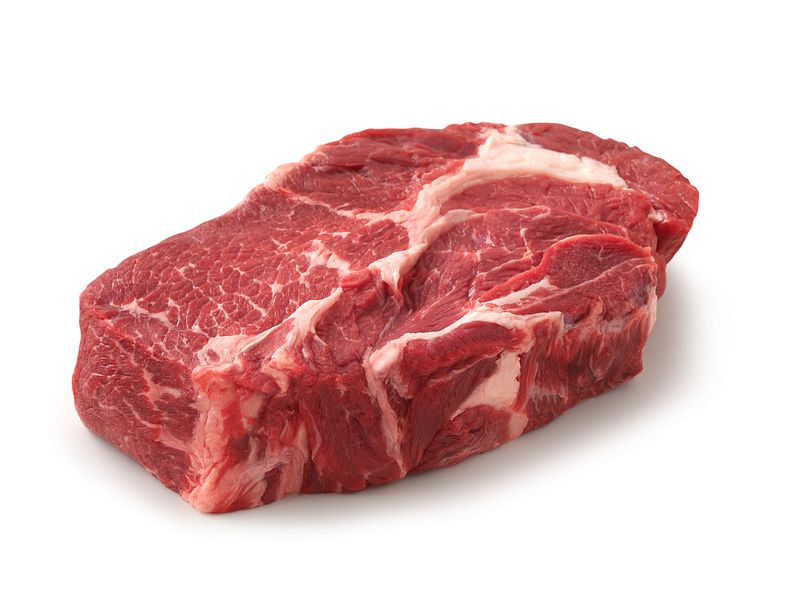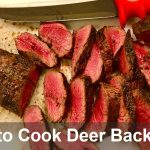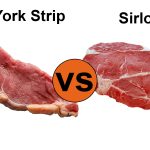Are you having a hard time deciding which cut of beef to use for your next roast? Arm roast and chuck roast are two popular cuts of beef, but it can be difficult to know when you should select one over the other. Each cut has its own unique characteristics and benefits, so read on to learn more about arm vs. chuck roasts in order to make an informed decision on which option is best for you. We’ll walk through taste preferences, tips on cooking each type of cut, cost comparison, and much more!
What is Arm Roast?

Arm roast, also known as top blade steak or shoulder center steak, is a cut of beef taken from the forequarter section. It’s located on the chuck primal, so it has plenty of marbling and connective tissue, making it an ideal choice for slow-cooking to tenderize the meat. Its semi-tough texture gives arm roast its signature flavor, which many people describe as having mild sweetness and bold depth.
Arm Roast Nutrition Facts
– Serving Size: 3 ounces (84g)
– Calories: 152
– Fat: 8.5g
– Sodium: 59mg
– Carbohydrates: 0g
– Protein: 20g
– Cholesterol: 71mg
– Vitamin A: 0% DV
– Vitamin C: 0% DV
– Calcium: 0% DV
– Iron: 8% DV
What is Chuck Roast?

Chuck roast is a cut of beef taken from the neck and shoulder area of the cow. This cut is much tougher than arm roast due to its higher amount of connective tissue, but that means it can handle longer cook times without drying out. Chuck roast typically has more marbling and fat than arm roast, which gives it its signature flavor — a bit beefier and richer than arm roast.
Chuck Roast Nutrition Facts
– Serving Size: 3 ounces (84g)
– Calories: 159
– Fat: 8.5g
– Sodium: 47mg
– Carbohydrates: 0g
– Protein: 20g
– Cholesterol: 71mg
– Vitamin A: 0% DV
– Vitamin C: 0% DV
– Calcium: 0% DV
– Iron: 11% DV
What Are The Benefits Of Each Cut?
Arm Roast: Arm roast is ideal for slow-cooking due to its semi-tough texture and marbling. This cut is also more affordable than chuck roast, making it a great choice when you’re on a budget.
Chuck Roast: Chuck roast has a richer beefier flavor with plenty of fat and marbling, so it can handle longer cook times without drying out. This cut is perfect for braising or slow roasting to create delicious pot roasts and stews.
Overall, both arm roast and chuck roast have their own unique characteristics that make them ideal for different types of dishes. Be sure to consider your taste preferences, cooking methods, and budget before deciding which option is best for you!
What Is The Difference Between Arm Roast and Chuck Roast?
The main difference between arm roast and chuck roast is in their Connective Tissue, Marbling, texture, taste, and cooking methods. Arm roast has a semi-tough texture with mild sweetness and bold depth of flavor. Chuck roast has a richer beefier flavor with more marbling and fat.
5 Differences Between Arm Roast and Chuck Roast
1. Connective Tissue: Chuck roast has more connective tissue than arm roast, making it tougher and better suited for slow-cooking methods such as roasting.
2. Marbling: Chuck roast typically has more marbling than arm roast, giving it a richer flavor.
3. Texture: Arm roast is semi-tough but still tender when cooked correctly, while chuck roast is much tougher in texture.
4. Cost: While both cuts are relatively inexpensive compared to other beef cuts, chuck roasts tend to be slightly less expensive than arm roasts because of their higher demand among cooks and chefs looking to make flavorful stews and pot roasts.
5. Taste: Arm roast has a mild sweetness and bold depth to its flavor while chuck roast has a beefier, richer taste.
6.Cooking methods: Arm roast is typically recommended to be cooked slowly over low heat, while chuck roast can handle longer cooking times without drying out due to its higher connective tissue content. Both cuts are great for dishes like roasts, stews and pot roasts.
Arm Roast vs Chuck Roast: Which Cut Is Better?
The decision of which cut is better comes down to personal preference. Both arm roast and chuck roast are great cuts of beef that can be used in a variety of recipes — from slow-cooker pot roasts to braised beef dishes. Consider your own tastes, needs, budget and cooking experience when deciding between these two cuts! If you’re looking for a more tender cut with mild sweetness to it, then arm roast is likely the best choice for you. Alternatively, if you prefer a heartier flavor and tougher texture, then chuck roast is probably the way to go.
Which Cut Is Tastier: Arm Roast or Chuck Roast?
This depends on personal preference! Both cuts are flavorful and tasty, but due to their differences in texture, each cut offers a different experience. Some people enjoy the mild sweetness of arm roast while others prefer the rich flavor of chuck roast. Ultimately, it’s up to you which type of cut you prefer.
How Should I Cook Arm and Chuck Roast?
Arm roasts should be cooked low and slow in order to give the meat time to tenderize. This could mean using your oven or slow cooker for a few hours on low heat. When cooking chuck roast, it’s important to get the temperature high enough that the connective tissue can properly break down without drying out the meat. Try searing the outside of the roast before transferring it into a Dutch oven with stock and vegetables for an hour or two until its fork-tender.
What Are Some Popular Dishes Made With Arm Roast or Chuck Roast?
Both arm roast and chuck roast are ideal for slow cooking, making them perfect for dishes like pot roasts, stews, braised beef dishes and more. Popular recipes that use these cuts of beef include classic Italian Beef Ragu, Braised Beef Short Ribs, Slow Cooker Pot Roast, and Creamy Beef Stroganoff.
How To Cook Arm Roast?
Arm roast is best cooked low and slow, either in the oven or a slow cooker. Start by seasoning the roast with salt and pepper to taste, then heat some oil over medium-high heat in a large skillet. Sear the outside of the roast for about 3-4 minutes per side until it’s nicely browned. Move the roast to a roasting pan or slow cooker, add any vegetables you want (such as chopped onions, carrots, celery), and cover with 1 ½ cups of beef stock or broth. Cover roasting pan/slow cooker with foil and cook in preheated oven at 325 degrees Fahrenheit (160 Celsius) for 2 hours (for rare) up to 4 hours (for well done). Once finished cooking, let the roast rest for 10-15 minutes before slicing and serving.
How To Cook Chuck Roast?
Chuck roast is best cooked by searing it first then transferring it to a Dutch oven or slow cooker with some liquid and vegetables. Start by seasoning the roast with salt and pepper to taste, then heat some oil over medium-high heat in a large skillet. Sear the outside of the roast for about 3-4 minutes per side until it’s nicely browned. Move the roast to a roasting pan or slow cooker, add any vegetables you want (such as chopped onions, carrots, celery), and cover with 1 ½ cups of beef stock or broth. Cover pan/slow cooker with lid and cook on low heat for 6-8 hours until the meat is fork-tender. Once finished cooking, let the roast rest for 10-15 minutes before slicing and serving.
What Are The Benefits Of Cooking With Arm Roast And Chuck Roast?
Cooking with arm roast and chuck roast provides many benefits to your meal! Both cuts are flavorful, tender, and economical and can be used in a variety of dishes. They’re also great sources of protein and essential vitamins and minerals that help keep you feeling full longer — making them perfect for hearty meals that will satisfy everyone at the table. Plus, their slow cooking methods help break down tough connective tissue while still keeping in all of the delicious flavors! So no matter which cut you decide to use, you’re sure to get an easy and delicious meal.
What Is The Best Way To Store Arm Roast And Chuck Roast?
Arm roast and chuck roast should be stored in the refrigerator or freezer until ready to use. If storing in the refrigerator, wrap the beef tightly in plastic and store for up to 3 days. For long-term storage, place in a sealed container or vacuum-sealed package before freezing for up to 6 months. When ready to cook, thaw out overnight on a plate or baking sheet in your fridge. This will ensure that any excess liquid stays away from the meat while it defrosts slowly. Once thawed, cook immediately using your preferred cooking method.
What Is The Best Way To Prepare Arm Roast and Chuck Roast?
The best way to prepare arm roast and chuck roast is to start by seasoning the meat with salt and freshly cracked pepper, then either searing it in a little oil on the stovetop or cooking it in the oven with some vegetables and liquid. Both methods will bring out all of the amazing flavors from these cuts of beef, but searing often produces a more flavorful crust. For slow cooked dishes like pot roasts, stews, braised beef dishes, let the meat cook low and slow for several hours until its fork-tender. This will ensure that all of its natural juices are retained while it heats up slowly, resulting in a juicy and tender piece of beef.
FAQs:
How long should I cook arm roast and chuck roast?
Depending on your desired level of doneness, cooks can usually expect to cook arm roasts and chuck roasts for anywhere from two to four hours at 325°F (160°C). For slow-cooked dishes like pot roasts or braised beef dishes, let the meat cook low and slow for several hours until it becomes fork-tender.
Can I use arm roast or chuck roast in a stew?
Yes, both cuts of beef are perfect for stews since they break down slowly when cooked and retain their flavor. Choose either the arm roast or chuck roast, then cube the meat before adding to your stew. Let the meat cook slowly over low heat until tender, about 4-6 hours depending on the size of the cubes. This will give you a delicious, flavorful stew that everyone can enjoy!
What is the best way to sear arm roast or chuck roast?
The best way to sear arm roast or chuck roast is to season the beef with salt and freshly cracked pepper, then heat a little oil in a large skillet over medium-high heat. Once hot, add the beef and cook for 3-5 minutes per side, or until a nice crust has formed. This will help lock in all of the delicious juices and flavors!
Is an arm roast better than a chuck roast?
It really depends on your preferences and the dish you’re making. The arm roast is a leaner cut of beef that has less marbling, which means it can dry out more easily when cooked. However, this also makes it a great choice for dishes where you don’t want too much fat or grease. On the other hand, chuck roast is fatty and marbled all over, so it’s perfect for slow-cooking dishes like pot roasts or braised dishes. So, in the end, it really just comes down to personal preference!
Can arm roast be substituted for chuck roast?
Yes, arm roast and chuck roast can be used interchangeably in most recipes. Though arm roast is a leaner cut of beef, it will still cook up tender and juicy with the right seasoning and cooking methods. Just keep an eye on the meat while it cooks to ensure that it doesn’t dry out too much. You might also need to adjust the cooking time slightly since arm roast tends to cook faster than chuck roast.
At what temperature should I cook arm roast or chuck roast?
For the best results, we recommend cooking arm roasts and chuck roasts at 325°F (160°C). For slow-cooked dishes like stews or pot roasts, you may want to reduce the oven temperature slightly to 300°F (150°C). This will let the meat cook slowly and evenly, ensuring it comes out juicy and flavorful.
Can arm roast or chuck roast be frozen?
Yes, both cuts of beef can be frozen for up to three months. To freeze them properly, wrap the raw meat in a double layer of plastic wrap and then place inside a sealed freezer bag. Freeze immediately upon purchase and make sure that the package is airtight so that no air gets in. When ready to use, thaw completely in the refrigerator overnight or using your preferred thawing method. Be aware that arm roast and chuck roast tend to become tough if they are not cooked correctly after being frozen, so make sure to follow proper cooking instructions.
What is the best way to keep arm roast or chuck roast moist?
The best way to keep arm roast or chuck roast moist is to cook it slowly over low heat, either in a slow cooker, in the oven, or on the stovetop. This will ensure that all of its natural juices are retained while it heats up slowly, resulting in a juicy and tender piece of beef. Additionally, you can help retain moisture by brushing the meat with oil before cooking and adding some liquid (like broth or wine) during the cooking process. Finally, make sure not to overcook your beef as this will cause it to become dry and tough.
Conclusion
When it comes to choosing the best roast for your next gathering, so much comes down to personal preference. Arm Roast and Chuck Roast offer unique qualities that will suit different palates. Arm Roast gives a flavorful roast with substantial marbling, which makes it ideal for slow-cooking. Chuck Roast is a tougher cut with less marbling, making it ideal for braising or stewing to break down its composition. If you’re looking for budget-friendly beef dish, then the price of chuck roast is ideal.
However, if you’re feast includes sides with stronger flavors and delicate textures, then arm roast could be the better choice. Ultimately, it depends on how you plan to prepare the roast, what side dishes you serve and how diners prefer their beef cooked! Knowing this info can help make sure your next roast dinner is one everyone will enjoy!
References:
https://fdc.nal.usda.gov/chuck, arm roast

William Lariviere is a chef and restaurateur with over 25 years of experience in the food industry. He is the owner and operator of Swartzsdeli.com, an online restaurant that specializes in gourmet sandwiches and salads, grill & smoke. He likes to share experience, food, recipes cooking knowledge as well as reviews about restaurant and kitchen products.
William’s goal is to provide his customers with healthy, delicious food that is also affordable and develop Swartzsdeli.com into a comprehensive information site specializing in cooking and cuisine to a new level to help reach a wide range of housewives and readers.








